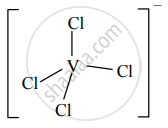Advertisements
Advertisements
Question
Answer the following question.
Give valence bond description for the bonding in the complex [VCl4]-. Draw box diagrams for the free metal ion. Which hybrid orbitals are used by the metal? State the number of unpaired electrons.
Solution
i. The oxidation state of vanadium is +3
ii. Valence shell electronic configuration of free metal ion, V3+

iii. The number of Cl– ligands is 4. Therefore, the number of vacant metal ion orbitals required for bonding with ligands must be four.
iv. Four orbitals on metal available for hybridisation are one s and three 4p. The complex is tetrahedral.

v. The four metal ion orbitals for bonding with Cl– ligands are derived from the sp3 hybridization.
vi. Four vacant sp3 hybrid orbitals of V3+ overlap with four orbitals of Cl– ions.
vii. Configuration after complex formation would be

viii. The complex has two unpaired electrons. The structure of [VCl4]– is

RELATED QUESTIONS
On the basis of CFT predict the number of unpaired electrons in [CrF6]3-.
Answer in brief.
What are the high-spin and low-spin complexes?
Answer in brief.
[CoCl4]2- is a tetrahedral complex. Draw its box orbital diagram. State which orbitals participate in hybridization.
Answer in brief.
[CoCl4]2- is a tetrahedral complex. Draw its box orbital diagram. State which orbitals participate in hybridization.
Answer in brief.
What are strong field and weak field ligands ? Give one example of each.
Answer in brief.
With the help of the crystal field, the energy-level diagram explains why the complex [Cr(en)3]3⊕ is coloured.
Answer the following question.
Draw a qualitatively energy-level diagram showing d-orbital splitting in the octahedral environment. Predict the number of unpaired electrons in the complex [Fe(CN)6]4-. Is the complex diamagnetic or paramagnetic? Is it coloured? Explain.
Answer the following with respect to [CoF6]3– ion
- Type of hybridization
- Number of unpaired electrons
- Geometry of complex ion
- Magnetic property
Identify the number of donor groups present in EDTA.
Chlorophyll and haemoglobin are complexes of ____________ respectively.
The number of unpaired electrons in the complex ion [CoF6]3− is ____________.
The INCORRECT match for complex with its geometry is:
The number of unpaired electrons in the complex ion [NiCl4]2− is ____________.
Identify the CORRECT statements regarding [Co(NH3)6]3+.
I. Oxidation state of metal ion = +3
II. It is a high spin complex.
III. It is paramagnetic.
IV. Metal ion undergoes d2sp3 hybridization.
Which of the following types of square planar complexes can show geometrical isomerism [M = metal, a, b, = monodentate ligand]?
Describe the bonding in the tetrahedral complex Ni(CO)4 on the basis of valence bond theory. Give the orbital diagrams of metal atoms in free state and in the complex. Mention the number of unpaired electrons in the complex.
Give VBT description of the bonding in a square planar complex [Cu(NH3) 4]2+. Show orbital diagrams for free metal ion and metal ion in the complex. Which hybrid orbitals are used by metal for bonding? State magnetic nature of the complex.
Give a valence bond description of the bonding in the high spin complex [MnCl6]3− Include orbital diagram for the free metal ion and the metal ion in the complex. Indicate which hybrid orbitals the metal ion uses for bonding. Specify the number of unpaired electrons.
A compound forms a hep structure. Calculate the number of octahedral voids in 0.4 mol. (NA = 6.022 × 1023).
A compound forms a hep structure. Calculate the number of octahedral voids in 0.4 mol. (NA = 6.022 × 1023 )
Give the limitations of VBT.
Mention the type of hybridization in [Co(NH3)6]3+ complex.
Mention the number of unpaired electrons and geometry of the following complex:
\[\ce{[Ni(CN)4]^2-}\]
